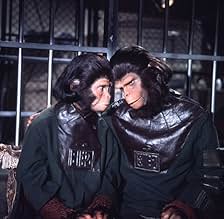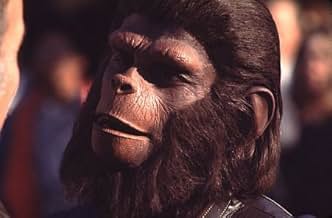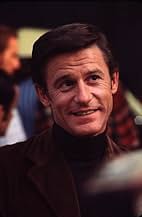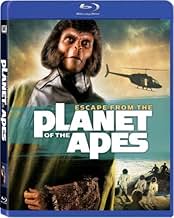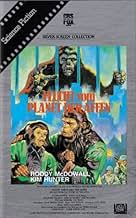El mundo está conmocionado por la aparición de tres chimpancés parlantes, que llegan misteriosamente en una nave espacial estadounidense. Se convierten en la flor y nata de la sociedad, pero... Leer todoEl mundo está conmocionado por la aparición de tres chimpancés parlantes, que llegan misteriosamente en una nave espacial estadounidense. Se convierten en la flor y nata de la sociedad, pero un hombre cree que son una amenaza.El mundo está conmocionado por la aparición de tres chimpancés parlantes, que llegan misteriosamente en una nave espacial estadounidense. Se convierten en la flor y nata de la sociedad, pero un hombre cree que son una amenaza.
- Premios
- 1 nominación en total
Argumento
¿Sabías que...?
- CuriosidadesThe film's villain, Dr. Hasslein, had been briefly mentioned at the beginnings of El planeta de los simios (1968) and Regreso al planeta de los simios (1970).
- PifiasThe ape world is an underdeveloped and primitive society that believe flight is not possible according to the first film. Yet, three apes were able to find Taylor's ship, raise it from the depths of a lake, dry it out completely right down to the electronic equipment, figure out how to fly it, then finally enter a time warp to bring themselves to 20th century Earth. (Note: Apparently, Dr. Milo - after raising the ship from the water (most likely with help) - studied the ship's technical manuals. Entering the time warp was accidental when the Alpha and Omega bomb had detonated while the ship had been in flight).
- Citas
Chairman of the President's Committee of Inquiry: [testing Lewis's assertion that the apes can speak] What is your name?
Dr. Zira: Zira.
Chairman of the President's Committee of Inquiry: One might as well be talking to a parrot.
Dr. Zira: A parrot?
Chairman of the President's Committee of Inquiry: What did I tell you? Mechanical mimicry. Unique in an ape, vocally, without a doubt, but... does the other one talk?
Cornelius: Only when she lets me.
- Créditos adicionalesThe 20th Century Fox logo does not appear on this film.
- ConexionesFeatured in Batalla por el planeta de los simios (1973)
In one respect Heston was to be proved right. "Planet of the Apes" is a classic, one of the best science-fiction movies ever made and one that combines an exciting plot with philosophical depth. It is frequently said that sequels are generally inferior to the original films, but seldom is this is as true as in the case of "Beneath the Planet of the Apes", a hopeless mess of a film. Neither its lack of artistic merit, however, nor its explosive ending dissuaded the filmmakers from making a third "Apes" film. An ingenious device was found to avoid the problems posed by planetary destruction; it is explained that shortly before the Earth was destroyed three of the apes found the wreckage of Taylor's spacecraft, repaired it and used it to travel back in time to 1970s America.
Although one of the apes is killed in an unfortunate incident shortly after arrival, the American public take to the two survivors, Cornelius and his wife Zira (both of whom played important parts in the first two films). The two intelligent, talking chimpanzees become media celebrities, and the early scenes are much lighter in tone than the two earlier films, at times even comic, as the two apes become after-dinner speakers and discover the joys of alcohol. The tone, however, gradually darkens. Figures in the government become alarmed by talk of a future in which men are dominated by apes, and Dr Hasslein, the President's sinister Germanic adviser, (based on Henry Kissinger?) is convinced that Zira and Cornelius represent a threat to the human race, especially after it is discovered that Zira is pregnant.
My disappointment with "Beneath...." had hitherto dissuaded me from watching any more of the later episodes in the "Apes" canon, so I was pleasantly surprised by "Escape.......". Although it lacks the depth and brilliance of "Planet of the Apes", it is considerably better than its immediate predecessor. The reason for its relative success lies with the fine contributions of its two stars, Roddy McDowell and Kim Hunter. Their characters played important supporting roles on the original film; here they take centre stage. The original had Heston's character Taylor at its centre, a human in danger from the apes. In "Escape......" the roles are reversed, with two lovable, and deeply human, apes in danger from humans. There is, however, a difference between the two films. The danger to Taylor came largely from ignorance; the apes, particularly Dr Zaius, saw him as a brute beast, like the other humans of their planet, and refused to listen to the evidence that suggested that he was, in fact, an intelligent being like themselves. Cornelius and Zira are in danger because of both their human and their non-human characteristics. Hasslein knows that they are intelligent beings who seem human and yet are not, and hates and fears them for precisely that reason. Just as they pitied and befriended Taylor, so they are in their turn befriended by two human scientists who try and save them from Hasslein.
There are a couple of inconsistencies between this and the earlier films, where the apes' society is shown as being technologically less advanced than ours, on a par with sixteenth or seventeenth century Europe. It is not explained how individuals from such a society could have succeeded in repairing and operating a spacecraft. Another inconsistency is that Cornelius and Zira know how the apes came to seize control of the Earth from humans and even state that this story is told in the Sacred Scrolls, the holy books of the apes' religion. In "Planet of the Apes" we are to understand that the Scrolls explicitly deny that humans ever had the powers of speech and reason, which is why Zaius is so reluctant to admit that Taylor can speak. These inconsistencies, however, are not really plot-holes as such and are unlikely to worry those who come to "Escape......." without having seen its predecessors. "Escape......." can be seen as a film in its own right rather than as a mere sequel, a film which starts out as a comedy and then turns into a serious thriller as the apes try to escape from their human enemies. Although it is less philosophical than the first film, it can perhaps be seen as an allegory of racism as Hasslein's paranoia leads him to treat as enemies those who bear no ill-will to him and his kind and whose only crime is to be different from him. It is significant that his name is derived from the German for "hate". 6/10
- JamesHitchcock
- 28 abr 2005
- Enlace permanente
Selecciones populares
- How long is Escape from the Planet of the Apes?Con tecnología de Alexa
Detalles
- Fecha de lanzamiento
- País de origen
- Sitios oficiales
- Idioma
- Títulos en diferentes países
- Escape from the Planet of the Apes
- Localizaciones del rodaje
- Empresas productoras
- Ver más compañías en los créditos en IMDbPro
Taquilla
- Presupuesto
- 2.500.000 US$ (estimación)
- Recaudación en Estados Unidos y Canadá
- 12.348.905 US$
- Recaudación en todo el mundo
- 12.348.905 US$
- Duración1 hora 38 minutos
- Color
- Relación de aspecto
- 2.39 : 1
Contribuir a esta página




